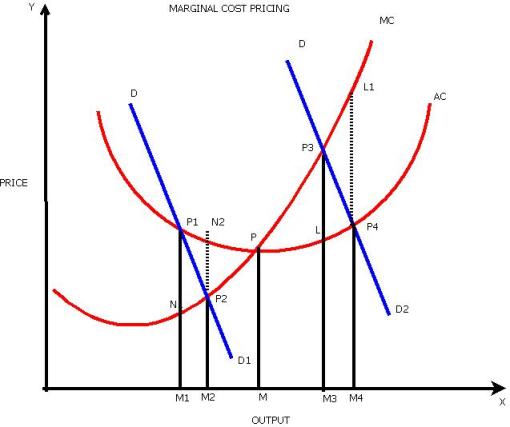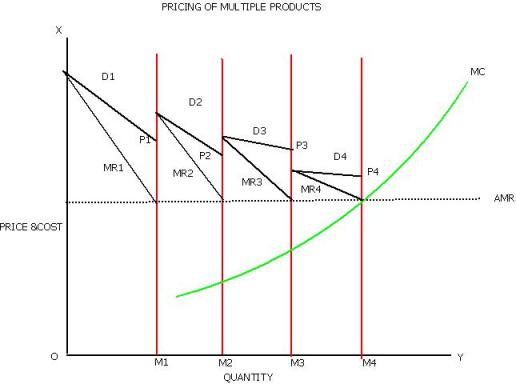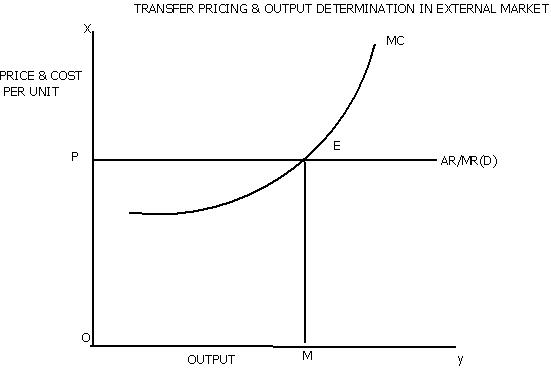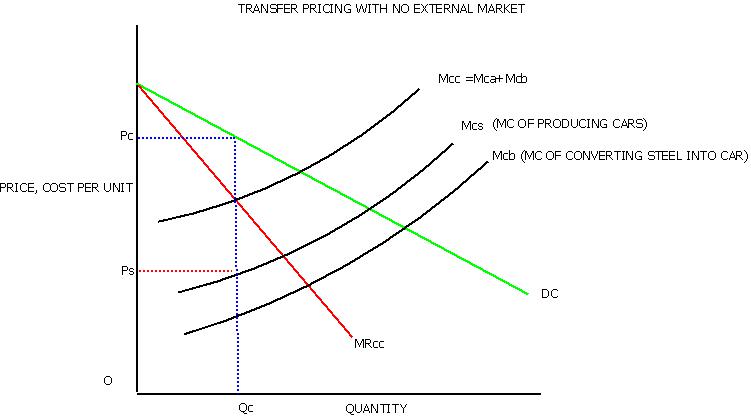Pricing Methods
MICROECONOMICS

|
Pricing Methods |

|
Introduction |
You are already aware about how the prices of goods are fixed.The demand for and the supply of a commodity determines the price of a commodity. In pricing methods ,we will be learning the basis of pricing of goods, which may not strictly follow the pricing principles. The influence of demand and supply of a commodity may change in different situations. The pricing of products may be influenced by cost conditions, demand conditions,psychological factors, the degree of competition, Government policies , nature of the market etc..For example, if the producer sells his products in different markets with varying elasticities of demand, he may adopt different pricing strategies. In a market where the demand is elastic, the producer may keep the prices low and in inelastic markets he may keep the prices high.The different pricing methods enables us to understand the dynamics of pricing
| Different Pricing Methods |
The pricing strategies enable the businesses to increase competitiveness and increase sales. Firms deploy a variety of pricing methods to attract customers and enlarge their market share. For example, some companies may offer very low prices to cater to the needs of middle class group. Others may keep the prices high and this may be justified on the basis of extra values provided. The consumers have the satisfaction that they are paying for something worthwhile, like better quality or the brand value.The pricing strategy will depend on the nature of the market under consideration.For example, in perfect competition,firms are price takers and hence prices will be competitive. Under monopoly, on the other hand, the firm is a price maker and hence he has a say in price fixation. Again the time in which a producer operates will influence price setting .Example- In a situation of short run, the firm may be forced to adopt a pricing method which will require him to charge a very low price to attract buyers and stay in business. These examples enable us to understand that pricing decisions may be based not only on supply and demand conditions. in fact, a number of other factors influence them.
| Full Cost Pricing |
This pricing method is used widely by producers.This is a traditional method of pricing popularly used by wholesalers, retailers, construction contractors In this method prices are set by adding a % of profit to the total cost of the output.This is known as the mark up price or a margin price.In this method,the cost of a product is calculated and a margin of profit is added on. There is empirical evidence to show that the producers usually set their prices on the basis of a cost plus a fair margin of profits.Fair profit is mostly a fixed percentage of profit , which is arbitrarily determined. Fair profit may differ from industry to industry or among firms in the same line of production. The variations occur due to factors like differences in turnover rate, differences in risks, intensity of competition etc.Full cost pricing is the simplest pricing method.In this method, basically the firm calculates the cost of a product and the markup % is added to arrive at the selling price.Full cost pricing can be done in two ways ie.full cost pricing which takes into consideration both variable and fixed costs and adds a percentage as markup Let us look at an example. The following are the components of cost for a producer.Variable Costs Materials = Rs. 150 and labor costs = Rs. 150 Total variable cost = Rs. 300.Suppose fixed cost = Rs. 300, total cost = Rs.600 and markup is 50%.If the markup is fixed as a % of total cost ,It will be 50% of Rs.600 ie..Rs. 300. . The selling Price = Rs.600 + Rs.300 + Rs. 900 per unit The other is direct cost pricing, which is variable costs plus a % markup. Thus the price charged will be such that it covers the average variable cost and the mark up . Thus, P = AVC + M, where M = markup measured as a % of AVC. Example- Suppose, a firm's AVC = Rs. 50and 10 % is the markup. The price P = 50 + 5 = Rs. 55 .This method, is used in the context of high competition since it leads to losses in the long run.
Markup may be cost based or sale price based.
Example -
The cost of a cycle = Rs.1000
Markup decided by the seller = Rs. 200
The selling price = Rs.1200
Markup % based on cost price =200/1000 = 20 %
Mark up % based on sale price= 200/1200 = 16.7 %
Usefulness of full cost pricing method
Full cost pricing is useful in situations under the following conditions
1.The costs are difficult to estimate in advance.
2. The producers are interested in maximizing their profits after considering the fixed costs 3. It is difficult to estimate costs in advance.4. The products are manufactured as per the specifications of customers. 5. It is difficult to estimate the expected demand at different price levels.
| Marginal Cost Pricing |
Diagram 1
 <
<
The marginal cost pricing method considers the allocation of resources as a base for pricing. The pricing is done in such a way so as to allocate the resources efficiently. For instance, in the case of publtc undertakings, the returns may not cover the costs. As a result, in the case of public undertakings the returns may not even cover the costs and hence in many cases pricing on the basis of marginal cost may not be profitable to the investor. Some public sector undertakings may have falling marginal costs. Marginal cost may be lower than average cost. In such a situation if the price is fixed by equating marginal cost and average revenue,it will lead to losses.This type of pricing may be resorted to to enable the public to buy certain essential goods.The diagram enables us to understand the pricing under different situations. Suppose the demand for a commodity is represented by the demand curve DD1.
At this level of demand OM1 output is produced and sold at M1P1 price. At this price normal profits are made. So price (Average revenue) = Average cost.
Public utility undertakings, which may be interested in distributing essential goods at lower affordable prices, may charge a price equal to the marginal cost. Suppose output OM2 is sold at a lower price M2P2..At this price DD1 cuts MC. Hence pricing is based on marginal cost in this case. But the loss is to the extent his is for public welfare. The loss will be borne by the Government. This is for public welfare. The loss will be borne by the Government. This is the case with commodities like kerosene, cooking oil, gasetc.. Now if there is more demand, higher prices may be charged. Price PM will be charged which is equal to average cost and marginal cost. This will result in normal profits.
If luxury items like ACs are produced and sold and their demand is represented by DD2, which is high, OM3 quantity may be offered at M3P3 price. Here DD 2 cuts MC curve. Extra profits = P3L . Production at lower price is possible at M4P4. At this point price= MC. At M4 output, people will not be ready to pay M4L1 price, which is equal to MC but higher than AC by L1P4. If the commodity is not an essential, a high price like this may be charged. The money from this is utilized by the Government to provide essential goods for low income groups.
| Multiple Product Pricing |
Have you noticed the various models of mobile handsets produced by one company, say Nokia, L.G? Why are various models manufactured? The answer to this is obvious. People choices are different depending upon their preferences, usage, aesthetic senses, snob appeal, fashion sense etc. For e.g. a person may go in for an ordinary model without added features, but priced less. So Nokia is producing different models to suit the varying needs of its customers. In this manner they can maximize sales or profit.so a firm may be producing variety of products which may differ in style, model, functions, sizes etc. so physically the models may be different and each one has market share. The models keep on changing to cater to the changing demand pattern. The producers also try to introduce new products along with old. Naturally the firm s will not have stable profit maximum point. It keeps on shifting. For firms producing multiple products, it is convenient to introduce new items since already the overhead expenses are incurred. Management and labor can also be common for many products. So if there is idle capacity it can be utilized to produce new products.For example, a firm produces a particular brand of car, say HyundaiI 10. The capacity utilization is 70 %. The marginal revenue will be equal to marginal cost and profits are made. The excess capacity can be used to produce another car or bike and if there is excess capacity still, he can go for a third product. In each of the product category, MR (extra income from the last unit) and MC (the cost of producing the last unit) will be equal. This is applicable to any number of new products and markets. The diagram illustrates multiproduct pricing. Market A has the demand curve A1. The second market has B2. MC is the marginal cost, which is common. OM1 quantity is sold in market 1 and M1 M2 quantity is sold in market 2. The horizontal line AMR is the aggregate marginal revenue curve. In equilibrium, the marginal revenues of different products will be equal to each other and all are equal to MC. The four markets have four demand curves and corresponding MR curves, MR1, MR2, MR3 and MR 4. Each product is charged differently. For example in the first market A the firm sells OM 1output. At this point MR1 = MC. The price charged is P1M1.The price charged is M2P2 in the second market and M3P3 in the third market and so on. It may be noted that in the above given example price is just above the MC. The demand in this market is elastic. So prices are also kept lower. So a rational producer will keep the prices low in such a situation to maximize profits. Thus, the producers in multi product pricing may sell different types or models of a commodity in different markets depending on elasticity of demand and thus make a profit.
| Transfer Cost Pricing |
Take the case of automobile manufacturing units like Tata Motors. The manufactures of cars are involved in the assembling of so many parts or intermediary goods like engines, tyres, radiators etc. These goods may be manufactured by the company itself. This is known as vertical integration which can be seen commonly in industrial units. This vertical integration enables the making of finished product i.e. the car easily. Vertical integration is very efficient system because the company will be able to enjoy a number of economies and the supply of intermediary goods will be smooth. Now in a vertically integrated firm, it is necessary to ensure that the final product fetches a profit. At the same time the pricing of intermediate goods should be taken care of. The producers intermediate goods should also make profits. The intermediate goods prices cannot be very high since it is the input for final output. So what is Transfer pricing?
Transfer pricing refers to the pricing of intra- firm transfer products.
In our e.g. the pricing of engine, radiators etc. become important for the final pricing. These are all products divisions or subsidiaries. They should also make profits. The intermediate products can also be sold in the external market. The parts of the car may be sold to the same manufacturing or the assembling section of the same company or to an outsider. In case there is no external market, the dealings are within the firm vertically and there has to be a price policy to guide the producers. If the firm is selling its products in the external market, prices prevailing outside the firm will guide in fixing the price. Let us discuss the two situations of transfer pricing to understand the pricing policy adopted by firms.
Transfer Pricing and Output Determination in the Case of the External Market
If there is an external market, the parent firm and the other intermediate production units do not depend on each other. The components in making unit of a car can sell to anyone outside the unit. The car making unit can buy the components either from its own production unit or from outside. It is assumed that the external market is perfectly competitive. It implies that the parent unit and the intermediate product units are free to sell and buy at the market determined price. This price will be equal to the marginal cost. The figure illustrates this. AR represents the demand curve of the components of the car. Let us take brakes, a component in the making of a car. OP is the market determined price. The output level at the point where marginal cost = price is OQ. If the brake manufacturing unit increases the price, the car manufacturing or assembling unit will buy from outside at a lower price. Similarly, if the car manufacturing unit is not ready to pay the market price the brake making unit will not sell it to the parent unit, but will sell it outside in the open market. What does this show? If there is an external market, the output of the production unit in an industry producing intermediate goods, in our example, brake need not be equal to the input demand of the parent production unit producing the final good. Thus excess brake units produced can be sold outside. Also if there is a shortage of brake units they can be bought in the open market.
Transfer Pricing without External Market
In situations where there are no external market dealings, the question will be what price to be charged for brake units by the brake making unit. It is obvious that the car manufacturing unit will benefit from a lower price. In a vertically integrated firm, the management will have to decide a transfer price for brake in such a way as to maximize overall profit for the entire production unit. The price fixed has to be optimal for the intermediate and final good. It implies that the brake making unit and the car making unit should be enabled to make a profit and the overall profits should be optimum.
The problem is solved in the following manner. The brake making unit will charge a price equal to the MC of producing steel. For the car unit ,which is the final product , MCC = MCa+ MCb. The car unit can choose OQ as the output at which price OP1 is charged. The price of brake units is fixed at OP at which they supply the brake units needed for the production of OQ number of cars.
The demand or the average revenue of the car = DC
The marginal revenue = MR cc
The marginal cost of producing steel for making cars = MCs
The marginal cost of producing cars from steel = MC b
Thus for the firm, the total marginal cost of producing cars = MCs + MC b = MCC OQ is the profit maximizing output. At which MR CC = MCC. . At this output, the transfer price of steel must be such that the car making unit will have to produce OQ cars. The steel makers also must supply the steel to enable the production of OQ units of cars at the given price. The management will ask the steel unit to charge a price ( OPS ) = Marginal cost of producing the steel. Thus the marginal cost of producing the steel + the marginal cost of converting the steel into cars = Marginal revenue. In this manner, the profits are maximized.

|
Activity |
| Write your activity here | |
| Example: {{{Example}}} |
|

|
Self-Assessment Questions (SAQs) {{{n}}} |
| {{{SAQ}}} | |

|
Results |

|
Key Terms |

|
References and Bibliography |

|
Further Readings |






